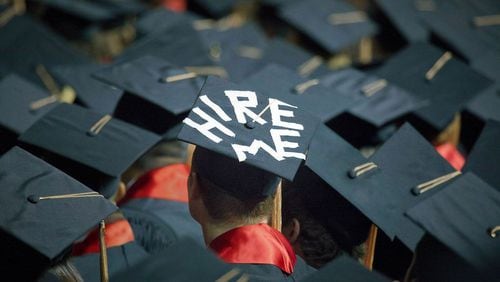As a parent about to dispatch my final two kids to college, I am far more concerned with their majors than when I sent off my oldest child 11 years ago.
In that time, I have learned more as a parent and reporter about the changing job market and seen one too many philosophy and English majors struggle to find meaningful jobs that pay enough to afford a house, a car and an occasional vacation.
Like many parents, I would prefer to let my children study what they find the most compelling, but I also know the job market favors math and science skills. I also know how expensive college is -- my older two are still paying off loans.
A new report from the Georgetown University Center on Education and the Workforce (Georgetown Center) addresses the disconnect between college and career.
Among the findings: Tuition and fees at public four-year colleges and universities have grown 19 times faster than family incomes since 1980. While college grads are generally happy with their decision to attend college, the study notes more than half would choose a different major, go to a different college, or pursue a different postsecondary credential.
I have met several college graduates with liberal arts degrees now back in school for nursing or physical therapy. Before they could get into those health programs, they had to shore up their science credentials by enrolling in courses at local colleges.
We still have a divide where college presidents herald the life of the mind and the mandate for universities to produce thinkers and explorers and creatives. Then, we have parents slipping their sociology and theater graduates $100 to pay the light bill and put gas in their clunker.
With that, here is the official release from the Georgetown Center on its report "Career Pathways: Five Ways to Connect College and Careers," which calls for states to help college students and employers understand the meaning of a degree and its value in the job market.
From Georgetown:
Back when a high school-educated worker could find a good job with decent wages, the question was simply whether or not to go to college. That is no longer the case in today’s economy which requires at least some college to enter the middle class. The study finds that:
•The number of postsecondary programs of study more than quintupled between 1985 and 2010 — from 410 to 2,260;
•The number of colleges and universities more than doubled from 1,850 to 4,720 between 1950 and 2014; and
•The number of occupations grew from 270 in 1950 to 840 in 2010.
•The variety of postsecondary credentials, providers, and online delivery mechanisms has also multiplied rapidly in recent years, underscoring the need for common, measurable outcomes.
College graduates are also showing buyer's remorse. While they are generally happy with their decision to attend college, more than half would choose a different major, go to a different college, or pursue a different postsecondary credential if they had a chance.
The Georgetown study points out that the lack of information drives the higher education market toward mediocrity. The report argues that postsecondary education and training needs to be more closely aligned to careers to better equip learners and workers with the skills they need to succeed in the 21st century economy and close the skills gap.
The stakes couldn’t be higher for students to make the right decisions. Since 1980, tuition and fees at public four-year colleges and universities have grown 19 times faster than family incomes. Students and families want — and need — to know the value they are getting for their investment.
“Increasing transparency around college and career outcomes for students is absolutely critical; better data is also indispensable to drive improvements on our campuses,” said Peter McPherson, president of the Association of Public and Land-grant Universities.
Going to college has become one of the biggest investments people make in their lives. College provides large rewards, with graduates earning over $1 million more over a lifetime than high school graduates, but also involves substantial risk, with a $3.4 million difference in lifetime earnings between the highest and lowest paying majors. Thus, integrating education and workforce data will go a long way in removing the guesswork for individuals navigating the college and career maze.
“Higher education has become a $500 billion computer without an operating system,” said Anthony P. Carnevale, director of the Georgetown Center and the report’s lead author. “Learners and workers need a modern guidance system with clear and comprehensive consumer information that will help them make good college and career decisions.”
Such a system will also help employers frustrated by skill shortages to more precisely identify and hire talented workers, colleges to refresh and strengthen their programs to improve student outcomes, and policymakers to better allocate resources to build strong economies.
A number of states have started to leverage integrated education and workforce data by developing publicly available information tools in the following five areas:
•Education Projections, Business Expansion, and Workforce Quality tools to help state economic and workforce leaders attract new employers and retain existing ones with data demonstrating that the state postsecondary education and training systems can provide workers with the needed skills.
•Program Alignment with Labor Market Demand tools to help college administrators, deans, and faculty members make program-related decisions that address labor market needs, while college and system administrators can demonstrate return on investment to state leaders.
•Curriculum Alignment with Workforce Requirements tools to help faculty members create curricula aligned with the applied skills and abilities that learners will need to succeed in their careers.
•Counseling and Career Pathways tools to help advisors support students in their educational and career decisions as well as identify and reach out to the learners who need additional support.
•Job Placement and Skills Gap Analysis tools to help workers determine if and how the knowledge, skills, abilities, interests, and work values they possess are transferable to new jobs. These tools also help workers assess skills gaps and provide connections to postsecondary education and training options that can prepare them for a career change.
Reducing the confusion around college and careers is the way to equip more individuals with the skills they need in the 21st-century economy and offer employers the skilled workforce they require.
Access the full report, Career Pathways: Five Ways to Connect College and Careers, at cew.georgetown.edu/CareerPathways.







